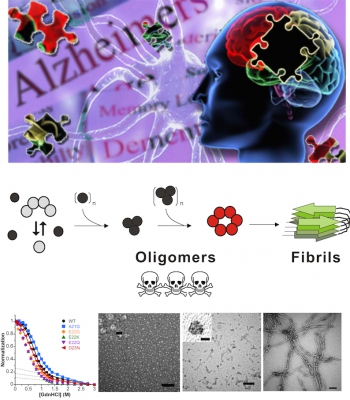| 姓名 | 陳韻如博士 |
|---|---|
| 現任 | 研究員 |
| 所屬單位 |
聚焦研究蛋白質錯誤摺疊及類澱粉蛋白疾病的致病機轉,特別關注阿茲海默症、漸凍人症等神經退化疾病。運用生物化學、生物物理、分子細胞和神經科學方法,深入探討類澱粉蛋白堆積、毒性、後修飾等相關病理機制,並開發新藥。 北卡羅萊納州州立大學生化系博士 1998-2003 台灣大學農業化學系學士 1992-1996 |
| 名片 |
|
| 研究方向/領域 |
研究方向/領域蛋白質錯誤摺疊及類澱粉蛋白疾病致病機轉 我們的研究重點在於運用多種生物化學、生物物理、分子細胞學和神經科學方法,來了解蛋白質錯誤摺疊之類澱粉沉積症的致病機轉。類澱粉沉積症多與神經退化疾病相關,其中阿茲海默症為本世紀全球及臺灣日趨嚴重的疾病。類澱粉蛋白是由錯誤摺疊的蛋白質堆積,而形成擁有專一乙級結構的纖維。類澱粉蛋白的堆積會形成許多不同的形狀物,而對神經細胞有毒害。很有趣的是,許多有著不同一級氨基酸序列的類澱粉蛋白,也有著共同的形狀物,這暗示著它們享有共同的堆積機制及相關毒性。我們將從了解致病蛋白堆積物的功能及機制,進而發展其偵測方式、有效抗體、及小分子抑制物。同時,我們亦研究類澱粉蛋白之醣化修飾及其調節物之影響與交互作用。我們希望能提供這些神經退化疾病早期診斷與治療的新方向,並進一步開發新藥以治療這些尚無有效藥物的重大疾病。 目前我們的研究著重於下列類澱粉蛋白及其作用分子:
|
經歷
- 2023-present Deputy Director, Genomics Research Center, Academia Sinica
- 2022-present Adjunct Professor/ Adjunct Research Fellow, Biomedical Translation Research Center, Academia Sinica, Taiwan
- 2022-2025 President, Asia Pacific Protein Association (APPA)
- 2021-present Adjunct Professor, Dept. of Biochemical Science & Technology, National Taiwan University, Taiwan
- 2021-present Professor, The Genomics Research Center, Academia Sinica
- 2015-present Adjunct Associate Professor, Dept. of Biochemical Science & Technology, National Taiwan University, Taiwan
- 2014-2021 Associate Professor, The Genomics Research Center, Academia Sinica
- 2015-2019 The World Academy of Sciences (TWAS) Young Affiliate
- 2014-2017 Council Member of Asia Pacific Protein Association (APPA)
- 2007-2014 Assistant Professor, Genomics Research Center, Academia Sinica, Taiwan
- 2006-2007 Postdoctoral Fellow, Genomics Research Center, Academia Sinica, Taiwan
- 2004-2002 Postdoctoral Fellow, Dept. of Molecular Biology & Biochemistry, University of California, Irvine, USA
榮譽
- 2024 第21屆國家新創精進獎。「對抗漸凍人及相關神經退化疾病的結構專一型單株抗體」
- 2024 國家生技研究園區招商暨人才與技術媒合會-投資青睞獎
- 2023 百靈佳殷格翰 2023 獨角獸2.0 -- 生醫新創加乘行動計畫
- 2023 國家生技園區全國生醫轉譯選拔媒合會-潛力團隊獎「針對漸凍人及相關神經退化疾病之新穎性治療抗體」
- 2023 中華扶輪教育基金會2022-23年度「傑出/特殊人才」獎
- 2023 Investigator Project Grant, Academia Sinica 中央研究院深耕計畫
- 2022 第19屆國家新創獎,「對抗漸凍人及相關神經退化疾病的結構專一型單株抗體」
- 2021 第十九屆有庠科技論文獎
- 108年度救國團青年獎章
- 技術團隊入選2018科技部未來科技展,作品”治療漸凍人及相關神經退化疾病的新穎抗體”
- 第14屆永信李天德青年醫藥科技獎
- 2017 Career Development Award, Academia Sinica 中央研究院前瞻計畫
- 2016年中國化學會傑出青年化學家獎章
- 104年度科技部吳大猷先生紀念獎
- 2015第三世界科學院年輕學者成員(國際獎項)
- 第十三屆有庠科技論文獎
- 104年度中研院年輕學者著作學獎
- 2015(國際獎項) Junior Faculty Award, the 12th International Conference on Alzheimer’s Disease and Parkinson’s Disease
- 財團法人吳健雄學術基金會103年度台灣女科學家新秀獎
- 中華民國生物物理學會102年度傑出年輕學者獎
- 2012 台灣臨床失智症學會財團法人立夫醫藥文教基金會學術獎
- 台灣生物化學及分子生物學會年輕學者出國研習優秀論文獎助2012 FAOBMB Congress
- 2011 台灣臨床失智症學會財團法人立夫醫藥文教基金會學術獎
- 2006-2007 Academia Sinica Postdoctoral Fellowship
- Gary Jen-Wei Chen§, Ming-Yun Chang§, Xin-Peng Lin, Debapriya Kundu, Yu-Jen Chang, and Yun-Ru Chen*, accepted, “Tau destabilization in a familial deletion mutant K280 accelerates its fibrillization and enhances the seeding effect”, JOURNAL OF BIOLOGICAL CHEMISTRY, 301(2), 108184. (SCIE)
- Ya-Ling Chiang, Yu-Jen Chang, Yun-Ru Chen, Ing-Shouh Hwang*, 2024, “Evidence Supporting Enrichment of Dissolved Air Gases near Hydrophobic Macromolecules in Aqueous Solutions”, Langmuir, 41(1), 285-291. (SCIE)
- Tien-Chang Lin‡, Orion Shih,b‡, Tien-Ying Tsai, Yi-Qi Yeh, Kuei-Fen Liao, Bradley W. Mansel, Ying-Jen Shiu, Chi-Fon Chang, An-Chung Su, Yun-Ru Chen*, and U-Ser Jeng*, 2024, “Binding structures of SERF1a with NT17-polyQ peptides of huntingtin exon 1 revealed by SECSWAXS, NMR and molecular simulation”, IUCrJ, 11(Pt 5), 849-858. (SCIE)
- Yu-Jen Chang, Kai-Tai Lin, Orion Shih, Chi-Hua Yang, Ching-Yu Chuang, Ming-Han Fang, Wei-Bin Lai, Yi-Chung Lee, Hung-Chih Kuo, Shang-Cheng Hung, Chi-Kuang Yao, U-Ser Jeng, Yun-Ru Chen*, 2024, “Sulfated disaccharide protects membrane and DNA damages from arginine-rich dipeptide repeats in ALS”, SCIENCE ADVANCES, 10, eadj0347. (SCIE)
- Tien-Ying Tsai, Wei-Ting Jhang, Hung-Kai Hsu, Yi-Tsu Chan, Chi-Fon Chang, Yun-Ru Chen*, 2024, “Amyloid Modifier SERF1a Accelerates Alzheimers Amyloid-β Fibrillization and Exacerbates the Cytotoxicity”, ACS Chemical Neuroscience, 15, 3,, 479-490. (SCIE)
- Chang, Yu-Jen; Chien, Yi-Hsin; Chang, Chieh-Chun; Wang, Pei-Ning; Chen, Yun-Ru*; Chang, Yun-Chorng*, 2024, “Detection of Femtomolar Amyloid-β Peptides for Early-Stage Identification of Alzheimer's Amyloid-β Aggregation with Functionalized Gold Nanoparticles”, ACS Applied Materials & Interfaces, 16, 3,, 3819-3828. (SCIE)
- Tien-Ying Tsai§, Chun-Yu Chen§, Tien-Wei Lin, Tien-Chang Lin, Feng-Lan Chiu, Orion Shih, Ming-Yun Chang, Yu-Chun Lin, An-Chung Su, U-Ser Jeng, Hung-Chih Kuo, Chi-Fon Chang, and Yun-Ru Chen*, 2023, “Amyloid Modifier SERF1a Interacts with PolyQ-expanded Huntingtin Exon 1 via Helical Interactions and Exacerbates PolyQ-induced Toxicity”, Communications Biology, 6, 767. (SCIE)
- Tien-Wei Lin, Jung-Kai Chang, Yih-Ru Wu, Tsung-Hsien Sun, Yang-Yu Cheng, Chien-Tai Ren, Mei-Hung Pan, Jin-Lin Wu, Kuo-Hsuan Chang, Hwai-I Yang, Chiung-Mei Chen*, Chung-Yi Wu*, and Yun-Ru Chen*, 2023, “Ganglioside-focused Glycan Array Reveals Abnormal Anti-GD1b Auto-antibody in Plasma of Preclinical Huntington’s Disease”, MOLECULAR NEUROBIOLOGY, 60(7), 3873-3882. (SCIE)
- Jin-Lin Wu and Yun-Ru Chen*, 2022, “Signal peptide stabilizes folding and inhibits misfolding of serum amyloid A”, PROTEIN SCIENCE, 31(12), e4485. (SCIE)
- Ming-Che Lee‡, Yi-Hung Liao‡, Shih-Hui Chen, and Yun-Ru Chen*., 2022, “Amyloid-β E22K Fibril in Familial Alzheimer’s Disease is More Thermo-stable and Susceptible to Seeding.”, IUBMB LIFE, 74(8), 739-747. (SCIE)
- Wan-Chin Chiang§, Yu-Sheng Fang§, Yuh-Shen Lye, Tzu-Yu Wong, Kiruthika Ganesan, Shih-Chieh Chou, Yun-Ru Chen*, 2022, “Hyperphosphorylation-mimetic TDP-43 Drives Amyloid Formation and Possesses Neuronal Toxicity at the Oligomeric Stage”, ACS Chemical Neuroscience, 37, 1,, 2599-2612. (SCIE)
- Jin-Lin Wu, Tung-Hung Su, Pei-Jer Chen, and Yun-Ru Chen*, 2022, “Acute‑phase serum amyloid A for early detection of hepatocellular carcinoma in cirrhotic patients with low AFP level”, Scientific Reports, 12, 5799. (SCIE)
- Yuh Shen Lye and Yun-Ru Chen*, 2022, “TAR DNA-binding protein 43 oligomers in physiology and pathology”, IUBMB LIFE, 2022, 1-18. (SCIE)
- Vu, Katrin; Lee, Ming-Che; Blankenburg, Gerhard; Chang, Yu-Jen; Chu, Ming-Lee; Erbe, Andreas; Lesser-Rojas, Leonardo; Chen, Yun-Ru; Chou, Chia-Fu*, 2021, “Time-evolved SERS signatures of DEP-trapped Aβ and Zn2+Aβ peptides revealed by a sub-10 nm electrode nanogap”, ANALYTICAL CHEMISTRY, 93(49), 16320-16329. (SCIE)
- Ya-Ling Chiang, Yu-Jen Chang, Yun-Ru Chen*, and Ing-Shouh Hwang*, 2021, “Effects of Dissolved Gases on Amyloid Fibril Morphology”, LANGMUIR, 37, 1,, 516-523. (SCIE)
- Yao-Hsiang Shih§, Ling-Hsien Tu§, Ting-Yu Chang, Kiruthika Ganesan, Wei-Wei Chang, Pao-Sheng Chang, Yu-Sheng Fang, Yeh-Tung Lin, Lee-Way Jin, and Yun-Ru Chen*, 2020, “TDP-43 interacts with amyloid-β, inhibits fibrillization, and worsens pathology in a model of Alzheimer’s disease”, NATURE COMMUNICATIONS, 11, 5950. (SCIE)
- Phillip Smethurst, Emmanuel Risse, Giulia E. Tyzack, Jamie S. Mitchell, Doaa M. Taha, Yun-Ru Chen, Jia Newcombe, John Collinge, Katie Sidle and Rickie Patani*, 2020, “Distinct responses of neurons and astrocytes to TDP-43 proteinopathy in amyotrophic lateral sclerosis”, BRAIN, 143(2), 430-440. (SCIE)
- Shih-Ling Huang, Lien-Szu Wu, Min Lee, Chin-Wen Chang, Wei-Cheng Cheng, Yu-Sheng Fang, Yun-Ru Chen, Pei-Lin Cheng, Che-Kun James Shen*, 2020, “A Robust TDP-43 Knock-In Mouse Model of ALS”, Acta Neuropathologica Communications, 8(1),3. (SCIE)
- Ling-Hsien Tu, Ning-Hsuan Tseng, Ya-Ru Tsai, Tien-Wei Lin, Yi-Wei Lo, Jien-Lin Charng, Hua-Ting Hsu, Yu-Sheng Chen, Rong-Jie Chen, Ying-Da Wu, Yi-Tsu Chan, Chang-Shi Chen, Jim-Min Fang,* and Yun-Ru Chen*, 2018, “Rationally Designed Divalent Caffeic Amide Inhibits Amyloid-β Fibrillization, Induce Fibril Dissociation, and Ameliorate Cytotoxicity”, EUROPEAN JOURNAL OF MEDICINAL CHEMISTRY, 158, 393-404. (SCIE)
- Chia-Jung Kuo, Hsu-Cheng Chiang, Chi-Ang Tseng, Chin-Fu Chang, Rajesh Kumar Ulaganathan, Tzu-Ting Ling, Yu-Jen Chang, Chiao-Chen Chen, Yun-Ru Chen, and Yit-Tsong Chen*., 2018, “A Lipid-Modified Graphene-Transistor Biosensor for Monitoring Amyloid-β Aggregation”, ACS APPLIED MATERIALS & INTERFACES, 10(15), 12311-12316. (SCIE)
- Ming-Che Lee, Wan-Cheng Yu, Yao-Hsiang Shih, Chun-Yu Chen, Zhong-Hong Guo, Shing-Jong Huang, Jerry C. C. Chan, and Yun-Ru Chen*, 2018, “Zinc ion rapidly induces toxic, off-pathway amyloid-β oligomers distinct from amyloid-β derived diffusible ligands in Alzheimer’s disease”, Scientific Reports, 8, 4772. (SCIE)
- Lin TW, Chang CF, Chang YJ, Liao YH, Yu HM, Chen YR*., 2017, “Alzheimer's amyloid-β A2T variant and its N-terminal peptides inhibit amyloid-β fibrillization and rescue the induced cytotoxicity”, PLOS ONE, 12(3), e0174561. (SCIE)
- Nguyen Quoc Thai, Ning-Hsuan Tseng, Mui Thi Vu, Tin Trung Nguyen, Huynh Quang Linh, Chin-Kun Hu*, Yun-Ru Chen*, and Mai Suan Li*, 2016, “Discovery of DNA dyes Hoechst 34580 and 33342 as good candidates for Alzheimer’s disease: in silico and in vitro study”, JOURNAL OF COMPUTER-AIDED MOLECULAR DESIGN, 30(8), 639-50. (SCIE)
- Yu-Jen Chang, Nguyen Hoang Linh, Hui-Ming Yu, Mai Suan Li*, and Yun-Ru Chen*, 2016, “Alzheimer’s Amyloid-β Sequesters Caspase-3 in vitro via its C-terminal Tail.”, ACS Chemical Neuroscience, 7(8), 1097-1106. (SCIE)
- Yu-Jen Chang, U-Ser Jeng, Ya-Ling Chiang, Ing-Shouh Hwang, and Yun-Ru Chen*, 2016, “Glycine-Alanine Dipeptide Repeat from C9orf72 Hexanucleotide Expansions Forms Toxic Amyloids Possessing Cell-to-cell Transmission Property”, Journal of Biological Chemistry, 291(10), 4903-4911. (SCIE)
- Chia‑Wei Lee, Lan‑Ling Jang, Huei‑Jyuan Pan, Yun‑Ru Chen, Chih‑Cheng Chen, and Chau‑Hwang Lee*, 2016, “Membrane roughness as a sensitive parameter reflecting the status of neuronal cells in response to chemical and nanoparticle treatments”, Journal of Nanobiotechnology, 14, 9. (SCIE)
- Patricia F. Kao, Yun-Ru Chen, Xiao-Bo Liu, Charles DeCarli, William W. Seeley, and Lee-Way Jin*, 2015, “Detection of TDP-43 oligomers in frontotemporal lobar degeneration-TDP”, ANNALS OF NEUROLOGY, 78(2), 211-221. (SCIE)
- Yu-Sheng Fang, Kuen-Jer Tsai, Yu-Jen Chang, Patricia Kao, Rima Woods, Pan-Hsien Kuo, Cheng-Chun Wu, Jhih-Ying Liao, Shih-Chieh Chou, Vinson Lin, Lee-Way Jin, Hanna S. Yuan, Irene H Cheng, Pang-Hsien Tu, and Yun-Ru Chen*, 2014, “Full-Length TDP-43 Forms Toxic Amyloid Oligomers that are Present in Frontotemporal Lobar Dementia-TDP Patients.”, Nature Communications, 5, 4824. (SCIE)
- Yu-Jen Chang, Yun-Ru Chen*, 2014, “The Co-existence of an Equal Amount of Alzheimer’s Amyloid-β 40 and 42 forms Structurally Stable and Toxic Oligomers through a Distinct Pathway”, FEBS JOURNAL, 281(11), 2674-2687. (SCIE)
- Huei-Jyuan Pan, Ruei-Lin Wang, Jian-Long Xiao, Yu-Jen Chang, Ji-Yen Cheng, Yun-Ru Chen, and Chau-Hwang Lee, 2014, “Using optical profilometry to characterize cell membrane roughness influenced by Amyloid-beta 42 aggregates and electric fields”, Journal of Biomedical Optics, 19(1), 011009. (SCIE)
- Man Hoang Viet, Chun-Yu Chen, Chin-Kun Hu, Yun-Ru Chen*, and Mai Suan Li*., 2013, “Discovery of Dihydrochalcone as potential lead for Alzheimer's disease: in silico and in vitro study”, PLoS One, 8(11), e79151. (SCIE)
- Rong-Jie Chen, Wei-Wei Chang, Yu-Chun Lin, Pei-Lin Pheng, Yun-Ru Chen*, 2013, “Alzheimer’s Amyloid-β Oligomers Rescue Cellular Prion Protein Induced Tau Reduction via Fyn Pathways”, ACS Chemical Neuroscience, 4(9), 1287-1296. (SCIE)
- Yi-Ting Wang, Pan-Hsien Kuo, Chien-Hao Chiang, Jhe-Ruei Liang, Yun-Ru Chen, Shuying Wang, James C. K. Shen, and Hanna S. Yuan*., 2013, “The truncated C-terminal RRM domain of TDP-43 plays a key role in forming proteinaceous aggregates.”, J Biol. Chem., 288(13), 9049-9057. (SCIE)
- Winny Ariesandi, Chi-Fon Chang, Tseng-Erh Chen,Yun-Ru Chen*, 2013, “Temperature-dependent structural changes of Parkinson's alpha-synuclein reveal the role of pre-existing oligomers in alpha-synuclein fibrillization”, PLoS One, 8(1), e53487. (SCIE)
- Yi-Hung Liao, Yu-Jen Chang, Yuji Yoshiike, Yun-Chorng Chang*, and Yun-Ru Chen*, 2012, “Negatively charged gold nanoparticles inhibit Alzheimer's amyloid-beta fibrillization, induce fibril dissociation, and mitigate neurotoxicity”, SMALL, 8(23), 3631-3639. (SCIE)
- Wei-Ting Chen, Chen-Jee Hong, Ya-Tzu Lin, Wen-Han Chang, He-Ting Huang, Jhih-Ying Liao, Chih-Ya Cheng, Hsiu-Chih Liu, Yun-Ru Chen*, and Irene H Cheng *, 2012, “Amyloid-beta (Abeta) D7H mutation increases oligomeric Abeta42 and alters properties of Abeta-zinc/copper assemblies ”, PLos One, 7(4), e35807. (SCIE)
- Chun-Lun Ni, Hoi-Ping Shi, Kuo-Ging Lin, Hui-Ming Yu, and Yun-Ru Chen*, 2011, “Folding Stability of Amyloid-beta 40 Monomer is an Important Determinant of the Nucleation Phase in Fibrillization”, Faseb Journal, 25(4),1390-1401. (SCIE)
- Wei-Ting Chen, Yi-Hung Liao, Hui-Ming Yu, Irene H. Cheng, and Yun-Ru Chen*, 2011, “Distinct Effects of Zn2+, Cu2+, Fe3+, and Al3+ on Amyloid-beta Stability, Oligomerization, and Aggregation: Amyloid-beta Destabilization Promotes Annular Protofibril Formation”, Journal of Biological Chemistry, 286(11), 9646-9656. (SCIE)
- Ni-Shian Lin, John Ching-Hao Chao, Fang-Chieh Chou, Chi-Fon Chang, Yun-Ru Chen, Yu-Jen Chang, Shing-Jong Huang, Wei-Hsiang Tseng, and Jerry C. C. Chan, 2010, “Molecular Structure of Amyloid Fibrils Formed by Residues 127 to 147 of the Human Prion Protein”, Chemistry - A European Journal, 16(18), 5492-5499. (SCIE)
- Yuji Yoshiike, Ryoichi Minai, Yo Matsuo, Yun-Ru Chen, Tetsuya Kimura, Akihiko Takashima* , 2008, “Amyloid Oligomer Conformation in a Group of Natively Folded Proteins”, PLos ONE., 3(9), e3235. (SCIE)
- Yun-Ru Chen and Charles G. Glabe*, 2006, “Distinct Early Folding and Aggregation Properties of Alzheimer Amyloid-b Peptide Aβ40 and Aβ42: Stable Trimer or Tetramer Formation by Ab42”, J Biol. Chem, 281, 24414-24422. (SCIE)
- Yun-Ru Chen and A. Clay Clark*, 2006, “Substitutions of prolines examine their role in kinetic trap formation of the caspase recruitment domain (CARD) of RICK”, Protein Science, 15, 395-409. (SCIE)
- Yun-Ru Chen and A. Clay Clark*, 2004, “Kinetic traps in the folding/unfolding of procaspase-1 CARD Domain”, Protein Science, 13, 2196-2206. (SCIE)
- Yun-Ru Chen and A. Clay Clark*, 2003, “Equilibrium and Kinetic Folding of the α-Helical Greek Key Protein Domain: Caspase Recruitment Domain (CARD) of RICK”, Biochemistry, 42, 6310-6320. (SCIE)
- C. Pop, Y. R. Chen, B. Smith, K. Bose, B. Bobay, A. Tripathy, S. Franzen and A. C. Clark*, 2001, “Removal of the pro-domain does not affect the conformation of the procaspase-3 dimer”, Biochemistry, 40, 14224-14235. (SCIE)
- 2025/01 用研究翻轉疾病 以蛋白質摺疊研究改寫神經退化性疾病未來
https://news.gbimonthly.com/tw/magazine/article_show.php?num=73949 - 2024/03/08 獲選「百靈佳殷格翰獨角獸2.0 生醫加乘行動計畫」
https://www.genomics.sinica.edu.tw/tw/news/honorsaawards/761-bi-bip2 - 2024/03/18 漸凍症治療新思路!中研院成功以硫酸雙醣分子減緩神經元退化
https://www.sinica.edu.tw/News_Content/55/2452 - 2020/11/27 更懂阿茲海默症!研究揪出疾病惡化的蛋白質幫兇
https://www.sinica.edu.tw/tw/News_Content/55/733 - 2014/11/14 華視新聞雜誌專訪
- 2014/09/16 TDP-43蛋白球狀多聚體是一導致失憶症的關鍵分子
- 2012/10/12 帶負電的奈米金粒子可導正阿茲海默症關鍵蛋白的錯誤摺疊




